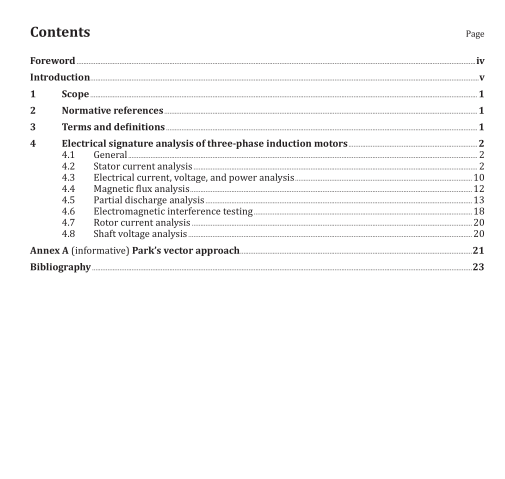BS ISO 20958:2013 pdf download.Condition monitoring and diagnostics of machine systems — Electrical signature analysis of three-phase induction motors
4 Electrical signature analysis of three-phase induction motors
4.1 General
The vast majority ot motors used in industry are induction machines.
Reliability surveys show that the most vulnerable parts of an induction motor are the bearings, the stator winding and core pack, and the rotor cage winding.
There is a lot of published material about a group of monitoring and diagnostic techniques, collectively referred to as electrical signature analysis, that can he used for condition monitoring of induction motors. In general, these techniques are based on the analysis either of signals available at the motor terminals or obtained through appropriate transducers fitted to the structure. Several of these techniques are presented in 42 to 4,..
The purpose of condition monitoring applied to three-phase induction motors is to assess the integrity of the motor and to provide early warning of possible faults. As an aid to this end, it is possible to obtain information about the health and integrity of an induction motor through analysis of its electrical signature. The variations in electric current, voltage, and power can equally be caused by the driven equipment, not just the motor; hence, the requirements of this International Standard, and electrical signature analysis, also apply to assessing the mechanical condition of the driven equipment.
If a motor is supplied from a variable voltage and frequency converter, care must be taken to account for current and voltage components in the output of such devices that could be misdiagnosed as resulting from motor defects. For techniques such as stator current analysis 42) and partial discharge (PD) analysis 45), it is advisable to lock the converter frequency and voltage while performing these tests.
4.2 Stator current analysis
4.2.1 General
Stator current analysis refers to measurements of the stator current. However, as the stator current is also affected by air gap fluxes and the rotor current, stator current analysis is capable of detecting problems in the rotor and the driven equipment.
4.2.2 Spectral analysis
Current signature analysis (CSA) has the capability of detecting the following problems in squirrel-cage and wound-rotor induction motors, where applicable:
— excessive air gap eccentricity;
— rolling element bearing defects;
— coupling misalignment;
— stator winding shorted turns;
— problems in the driven equipment
From this list, the most significant and damaging of these are rotor cage winding problems, eccentric air gaps, and rolling element bearing defects. Rolling element bearing defects are included since CSA can identify these defects that may also be identified by vibration monitoring.
Conventional CSA is done online at or close to normal full load. The current on one motor phase is analysed for its current frequency content by measuring it with a clip-on current transformer around a motor supply cable (see Figure 1) or around the secondary side of a current transformer (CT) (see Figure 2). Newer approaches can analyse all three phases and also look at the relation between current and voltage.
Care should be taken when interpreting the results of stator spectral analysis when the motor is driving a time-varying mechanical load since different phenomena can lead to similar characteristic frequencies showing up in the stator current. Some additional means of discriminating between the possible different causes may be required.
4.2.3 Rotor cage defects
CSA monitoring has revolutionized the detection of broken rotor bars and cracked short circuit rings in squirrel-cage induction (SCI) motor rotors. Specific frequencies in the current indicate the presence of defective rotor windings during normal operation of the motor. The detection of broken rotor bars by CSA can sometimes also be confirmed by bearing vibration analysis. References [19] and [27] independently pioneered current signature analysis in the late 1970s. In simple terms, the current flowing in the stator winding not only depends on the power supply and the impedance of the stator winding, but also includes current induced in the stator winding by the magnetic field from the rotor. That is, the stator winding is a probe or “transducer” for problems in the rotor.
The key issue is separating currents that flow through the stator to drive the rotor from the currents that the rotor induces back into the stator if there is a problem. This separation is accomplished by measuring current components at frequencies other than power frequency, using a high-resolution frequency spectrum analyser.BS ISO 20958 pdf download.ISO 20958-2013 pdf download
